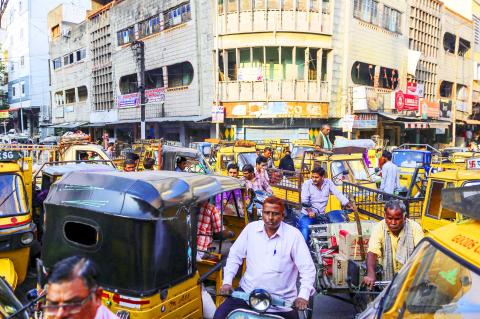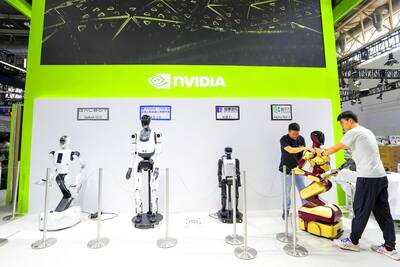A handful of fed-up residents in one of the world’s noisiest cities have taken on a daunting challenge: persuading Indian drivers to stop honking their car horns. Non-stop beeping has become the dominant soundtrack to Mumbai as clattering rickshaws, public buses, clapped-out taxis, weaving motorbikes and private cars fight for space on the traffic-clogged roads.
Now two separate teams in the city have come up with devices aimed at instilling some peace: one by forcing overzealous horn-users to open their wallets, and another by simply attacking drivers’ consciences.
“People blow their horns just for no sake,” said Jayraj Salgaonkar, who with a group of engineers has developed the “Oren horn usage meter” (the name “Oren” derives from local pronunciation of the word “horn”).

Photo: Bloomberg
The meter does not prevent the horn from working, but instead allows for a limited amount of honking, after which it causes the vehicle’s tail-lights to flash and alert the traffic police, who could then issue a fine.
The driver gets green, amber and red-light warnings over his honk allowance and can top up his meter “like a pre-paid phone card,” Salgaonkar said.
He is in talks with local authorities to get the device mandated city-wide.
“I have invested money and time and emotion,” he said, relating his years of exasperation with the city’s cacophony.
“People take pride in honking their horn. There’s an ego trip over having a car. Until you make people pay for their usage of the horn, it’s not going to work,” said the publisher-turned-honk-activist, who is hoping that the potential revenues brought by the system will help persuade authorities to adopt it.
The second invention, also vying for official sanction, less publicly castigates the honkers.
‘Project Bleep’ involves a little red button on the dashboard that beeps and flashes with a frowning face, “to make the driver conscious that he just honked and make him deliberate why he did it,” said Mayur Tekchandaney, one of its creators.
“Mostly it’s habitual. The driver doesn’t realize he’s doing it,” he said.
After testing the device on 30 drivers over six months, Tekchandaney and his team at Mumbai design firm Briefcase found an average 61 percent reduction in honking.
“The benefit is to other people on the road, society in general. It creates a nuisance for the driver,” Tekchandaney said.
Their goal may sound ambitious in a country where honking is so pervasive that foreign car makers, such as Audi and Volkswagen, fit their Indian vehicles with stronger, longer-life horns.
Nationwide, the messages “Horn OK Please” or “Blow Horn” are colorfully painted on the back of most trucks, encouraging drivers to make their presence audibly known as they overtake.
And the noise is only set to increase as more vehicles pile into densely-packed Mumbai, where the middle-class is growing and whose shoddy infrastructure and crowded trains do little to encourage the use of public transport.
There are now about 900,000 cars, 10,000 buses and 2 million two-wheelers plying the roads of the financial capital with a population of about 12 million, local transport expert Ashok Datar said.
Their horns are not just an annoyance, say anti-noise crusaders, who warn that honking is taking a worrying toll on the health of Indian city-dwellers — especially when combined with construction projects, roadworks and various religious festivals, which are often celebrated with ear-splitting firecrackers.
“In hospitals I know people who have suffered very severely even in intensive care units because of the noise [outside],” said Sumaira Abdulali, founder of the Awaaz Foundation which campaigns against noise pollution.
She said sound levels in busy parts of Mumbai continuously exceed 85 decibels, breaking the limits recommended by health experts and contributing to high blood pressure, hearing loss and heart disease.
“A lot of people in Mumbai are suffering these things and the medical costs are quite high. Cutting down noise would cost much less,” she said.
In the capital, New Delhi, a group of campaigners takes to the streets several times a month, plastering cars with “Do Not Honk!” stickers.
In southern Bangalore, residents last year launched an “I Won’t Honk Campaign,” backed by Indian cricketer Rahul Dravid, which aimed to get drivers pledging not to use their horns unless completely necessary.
However, given the ingrained habit of honking, it seems such campaigns or gadgets are unlikely to work unless they are made compulsory.
“Most people say there is excess honking, but they think it’s the other drivers,” said Ram Prasad at Final Mile, a behavioral research group in Mumbai which has examined the honking phenomenon.
Prasad also warned that introducing traffic police fines may only encourage bribing, giving drivers the feeling that “they have only extra licence to blow and honk.”
“Any device that gives subtle feedback, people will be more willing to take,” he said.

UNCERTAINTIES: Exports surged 34.1% and private investment grew 7.03% to outpace expectations in the first half, although US tariffs could stall momentum The Chung-Hua Institution for Economic Research (CIER, 中華經濟研究院) yesterday raised its GDP growth forecast to 3.05 percent this year on a robust first-half performance, but warned that US tariff threats and external uncertainty could stall momentum in the second half of the year. “The first half proved exceptionally strong, allowing room for optimism,” CIER president Lien Hsien-ming (連賢明) said. “But the growth momentum may slow moving forward due to US tariffs.” The tariff threat poses definite downside risks, although the scale of the impact remains unclear given the unpredictability of US President Donald Trump’s policies, Lien said. Despite the headwinds, Taiwan is likely

READY TO BUY: Shortly after Nvidia announced the approval, Chinese firms scrambled to order the H20 GPUs, which the company must send to the US government for approval Nvidia Corp chief executive officer Jensen Huang (黃仁勳) late on Monday said the technology giant has won approval from US President Donald Trump’s administration to sell its advanced H20 graphics processing units (GPUs) used to develop artificial intelligence (AI) to China. The news came in a company blog post late on Monday and Huang also spoke about the coup on China’s state-run China Global Television Network in remarks shown on X. “The US government has assured Nvidia that licenses will be granted, and Nvidia hopes to start deliveries soon,” the post said. “Today, I’m announcing that the US government has approved for us

When Lika Megreladze was a child, life in her native western Georgian region of Guria revolved around tea. Her mother worked for decades as a scientist at the Soviet Union’s Institute of Tea and Subtropical Crops in the village of Anaseuli, Georgia, perfecting cultivation methods for a Georgian tea industry that supplied the bulk of the vast communist state’s brews. “When I was a child, this was only my mum’s workplace. Only later I realized that it was something big,” she said. Now, the institute lies abandoned. Yellowed papers are strewn around its decaying corridors, and a statue of Soviet founder Vladimir Lenin

The National Stabilization Fund (NSF, 國安基金) is to continue supporting local shares, as uncertainties in international politics and the economy could affect Taiwanese industries’ global deployment and corporate profits, as well as affect stock movement and investor confidence, the Ministry of Finance said in a statement yesterday. The NT$500 billion (US$17.1 billion) fund would remain active in the stock market as the US’ tariff measures have not yet been fully finalized, which would drive international capital flows and global supply chain restructuring, the ministry said after the a meeting of the fund’s steering committee. Along with ongoing geopolitical risks and an unfavorable